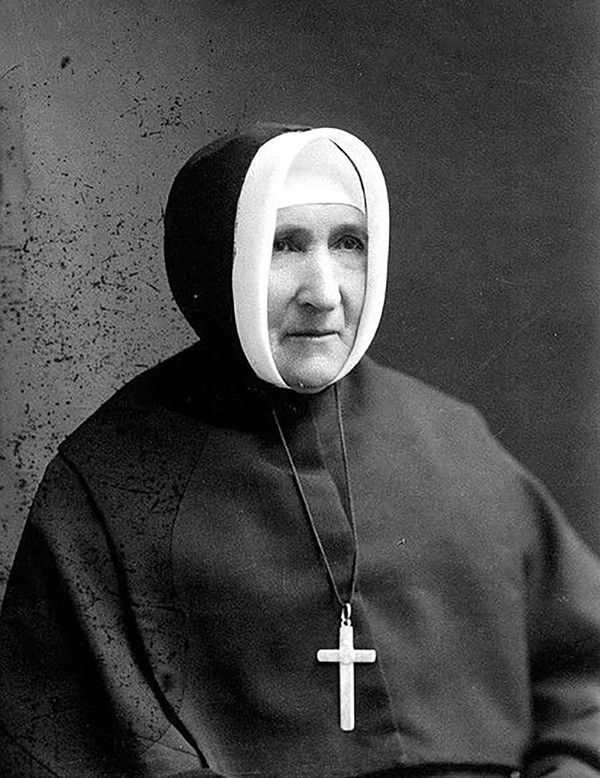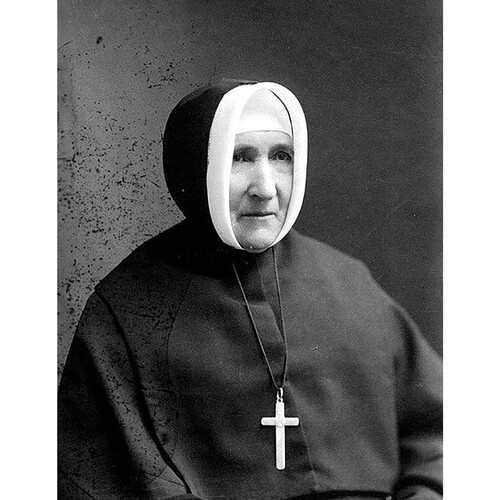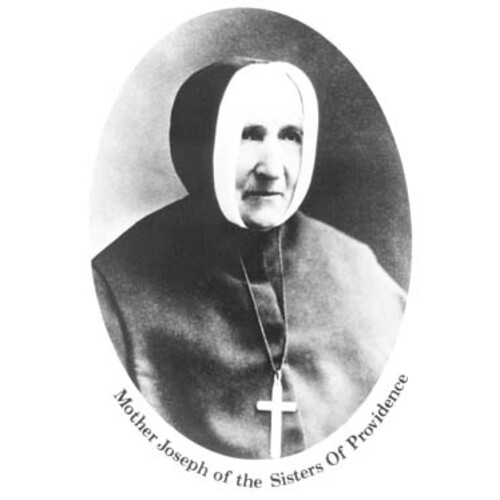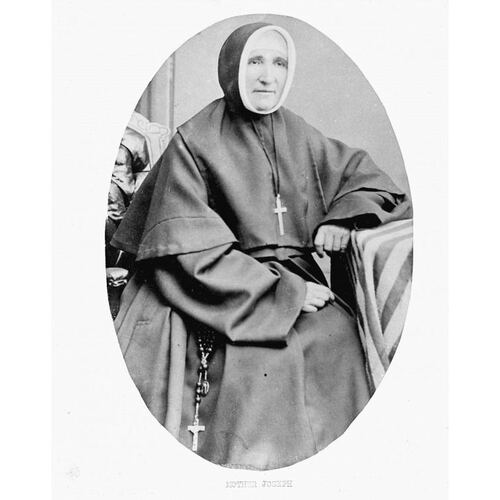
Source: Link
PARISEAU (Parizeau), ESTHER, named Joseph du Sacré-Cœur, Sister of Charity of Providence, builder, architect, and artisan; b. 16 April 1823 in Saint-Martin (Laval), Lower Canada, daughter of Joseph Pariseau and Françoise Rousseau; d. 19 Jan. 1902 in Vancouver, Wash., and was buried in Seattle.
Esther Pariseau’s father, a carriage maker well known locally for his skill as an artisan and his good judgement, taught the secrets of his trade to her when she was still a child. She proved to be as talented at working in wood as she was at the domestic tasks her mother taught her, such as sewing, embroidery, spinning, weaving, and cooking. On 26 Dec. 1843 she chose religious life and requested admission to the Sisters of Charity of Providence, a community recently founded by Emilie Tavernier*. The 13th candidate accepted, she went through the stages of postulant and novice and did two periods of practical training. At the Hôtel-Dieu in Montreal she learned how to care for the sick, and in the Congregation of Notre-Dame how to do fine embroidery and make liturgical ornaments, among other things. She took her vows on 21 July 1845 under the name of Sister Joseph du Sacré-Cœur. In her first years she worked in the candle-making shop, the pharmacy, the sewing rooms, and the waxworks. She became an officer with the resident students and a nurse to the nuns, and then was promoted counsellor and assistant. Because of her varied talents she was chosen on 3 Oct. 1856 to open and direct a mission of the Sisters of Providence in the diocese of Nesqually, Washington Territory, whose bishop was Augustin-Magloire Blanchet*.
Mother Joseph du Sacré-Coeur and her companions arrived in Vancouver, Wash., in December after travelling for more than a month. Nothing had been made ready for them, and they were obliged to take shelter in the attic of the bishop’s modest residence. Thanks to her talent and courage, by February 1857 they were able to move into a wooden house that they had had built to serve as convent and school. They were soon taking in orphans and the elderly, and then began to visit the poor and care for the sick in their homes. In the spring of 1858 they opened the Hôpital Saint-Joseph. As needs dictated and as their modest means permitted, more and more little houses were put up, creating the “faubourg de la Providence.” In the early 1860s the nuns began caring for the insane.
In September 1863, after opening a mission in Walla Walla, Mother Joseph du Sacré-Cœur undertook the long journey to Montreal, where she studied sculpture and statuary. She set out to return with the equipment needed for opening a carding-mill, accompanied (as would be the case during all her subsequent trips) by a new contingent of nuns. After her arrival in Vancouver on 23 Sept. 1864, she conducted two major fund-raising campaigns in order to put her mission back on its feet financially. The first lasted a fortnight; the second went on for several months among the miners in the region and brought in the tidy sum of $3,000.
In 1866 Mother Joseph du Sacré-Cœur gave up office as superior. She was then given charge of building and financing missions in the Canadian and the American west. In 1873 she was authorized to undertake construction of the Académie de la Providence in Vancouver. The largest brick structure in the region at the time and now officially an historic building, this immense house brought the community’s various activities under one roof.
Requests came thick and fast. In 1874 the sisters agreed to put up a hospital in Portland, Oreg. Mother Joseph du Sacré-Cœur worked on the plans and supervised the project. Two years later she returned to the mother house in Montreal, where she hoped to obtain assistance. She then went back to the United States, to face other challenges: the construction of the Hôpital de la Providence in Seattle, Wash., as well as the Collège des Saints-Anges and the Hospice Sainte-Marie in Vancouver. In 1880 she drew up the plans and supervised the building of hospitals in Walla Walla and in Astoria, Oreg. In the same year the École Saint-Michel in Olympia, Wash., and the École de la Providence Saint-Martin in Frenchtown, Mont., were erected. Also in 1880 she completed the chapel of the Maison de la Providence des Saints-Anges, in Vancouver, for which she herself made the mouldings and did the carving for the altars and columns.
Mother Joseph du Sacré-Cœur subsequently enjoyed a brief respite, during which she travelled for the third time to the mother house in Montreal. There she made known the needs of the western missions and asked for assistance. She then resumed her vocation as a builder. In 1885 she erected the Académie du Sacré-Cœur in Missoula, Mont. The following year she built the Hôpital du Sacré-Cœur in Spokane, Wash., the Hôpital Sainte-Claire in Fort Benton, Mont., and the Académie Saint-Joseph in Sprague, Wash. In 1887 it was Olympia’s turn to ask for a hospital, to be dedicated to St Peter. In the spring of 1888 Mother Joseph du Sacré-Cœur made another trip to Canada, which was followed by the construction of the Hôpital Saint-Jean-de-la-Croix in Port Townsend, Wash., in the fall and, in 1890, a hospital for the Saint-Eugène mission in the Kootenay region of British Columbia.
Requests for the Sisters of Providence were now coming in from all over. As soon as the missions were approved, Mother Joseph du Sacré-Cœur studied the needs and began putting up the necessary buildings. These included, in 1891, the Hôpital de la Providence in Wallace, Idaho, and the Hôpital Sainte-Élisabeth in Yakima, Wash. In 1892, on the occasion of the 400th anniversary of Christopher Columbus’s landing in America, Great Falls, Mont., requested the construction of the Hôpital Columbus, and Mother Joseph du Sacré-Cœur’s services were called on once again. No challenge daunted her. The year 1893 was marked by the erection of the Hôpital Saint-Ignace in Colfax, Wash., the building of an addition to the Seattle hospital, and the first steps towards the construction of the Hôpital Saint-Paul in Vancouver, B.C.
In 1894 Mother Joseph du Sacré-Cœur was appointed provincial counsellor. The following year her fellow nuns celebrated her golden jubilee, and for three days presents and testimonials poured in from both Canada and the United States. Despite these honours she did not cease her activity. She was put in charge of renovating the farm on which the survival of the Vancouver mission largely depended.
Back in Montreal in 1898, Mother Joseph du Sacré-Cœur showed herself deeply concerned about the financial situation of all the institutions she had built. For a year she sought recruits for the western missions and raised funds for them. She embroidered a tabernacle veil of fine gold, which was presented to Archbishop Paul Bruchési* in 1900, on the centennial of Émilie Tavernier’s birth. Her career as a builder came to an end with the construction of the Orphelinat de la Providence in New Westminster, B.C.
Although she had become blind in one eye, Mother Joseph du Sacré-Cœur did not indulge in self-pity. She was often to be found bringing help to prisoners. In 1900 she went to Cranbrook, B.C., to offer her advice to the builders of the Hôpital Saint-Eugène. That year she sent her comments to the general council on the constitutions of the community, which Rome had recently approved. She set up a library and began to put together a museum for the students. Although her strength was failing, in February 1901 she was consulted about new building proposals for the hospitals in Spokane and Seattle. Her health deteriorated rapidly and she died on 19 Jan. 1902. There were widespread expressions of sympathy. The superior general, Mother Marie-Antoinette [Blanchard*], summed them up: “Mother Joseph had the kind of lofty ideas, the kind of fertile inspirations that are the mark of genius; never-ending work, incalculable sacrifices, vast undertakings, nothing was too much for her energy and her generous initiative. She exerted an extraordinary influence on the church in the west.”
In 1953 the American Institute of Architects named Mother Joseph du Sacré-Cœur “the first architect of the Pacific Northwest”; the West Coast Lumbermen’s Association recognized her as “the first White artisan to work with wood in the Pacific Northwest.” On 1 May 1980, in the Capitol in Washington, D.C., a statue of Mother Joseph du Sacré-Cœur was unveiled in the gallery of the House of Representatives. There is also a statue of her in the Washington State capitol in Olympia.
Arch. des Sœurs de la Charité de la Providence (Montréal), Chroniques de la Providence des Saints-Anges, Vancouver, Wash., 1 (1857–90)-II (1890–1922). A brief historical sketch of the academy (Vancouver, 1977). Eighteen fifty-nine to nineteen eighty-four, 125 years of corporate caring (Seattle, Wash., 1984). The good work of Mother Joseph (Seattle, 1986). J. P. Greeley, Mother Joseph (Seattle, 1980). C. F. McGrasson et al., The bell and the river (Palo Alto, Calif., 1956). Sœur Mary James, “Tribut à mère Joseph du Sacré-Cœur,” Le Petit Journal de la Providence (Montréal), 26 (1929), suppl. janvier–février: 149–56. J.-G. Morin, “Pionnière de la civilisation au Nord-Ouest américain,” Sainte Anne de Beaupré (Sainte-Anne-de-Beaupré, Qué.), 104 (1976): 80–81. Mother Joseph, Marcus Whitman (Washington, 1980).
Cite This Article
Huguette Lapointe-Roy, “PARISEAU (Parizeau), ESTHER, named Joseph du Sacré-Cœur,” in Dictionary of Canadian Biography, vol. 13, University of Toronto/Université Laval, 2003–, accessed April 4, 2025, https://www.biographi.ca/en/bio/pariseau_esther_13E.html.
The citation above shows the format for footnotes and endnotes according to the Chicago manual of style (16th edition). Information to be used in other citation formats:
| Permalink: | https://www.biographi.ca/en/bio/pariseau_esther_13E.html |
| Author of Article: | Huguette Lapointe-Roy |
| Title of Article: | PARISEAU (Parizeau), ESTHER, named Joseph du Sacré-Cœur |
| Publication Name: | Dictionary of Canadian Biography, vol. 13 |
| Publisher: | University of Toronto/Université Laval |
| Year of revision: | 1994 |
| Access Date: | April 4, 2025 |





